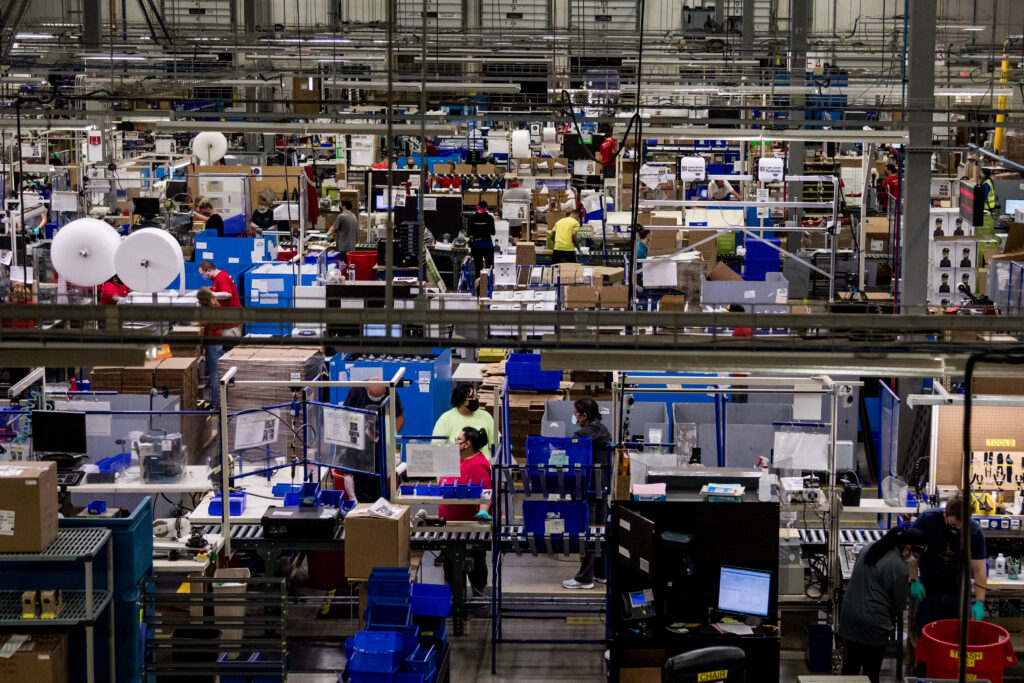When Viega LLC began hiring for its new factory in northeast Ohio last year, company officials ran traditional “help wanted” ads, retained outside recruiters, created a special website and even posted openings on roadside billboards.
Nothing worked. Viega used all the customary tools, and yet for months, the maker of plumbing and HVAC systems had little to show for its efforts. With area unemployment low, Viega’s requirement that new hires endure a lengthy training program four states away did not help.
The company’s struggle reflects a chronic shortage of manufacturing workers that could imperil the domestic factory boom that President Donald Trump has promised will result from his protectionist trade policy. Nationwide, manufacturers report 409,000 job openings, a number that is likely to swell if Trump’s tariffs produce a significant reshoring of factory work in the next few years.
“It was actually pretty challenging at first,” said Brooke Bacon, Viega’s chief people officer. “It’s not like there’s lots of people who are unemployed looking for work. So you’re trying to pull people away from something that they’ve known to something … that was a tough sell.”
Viega eventually sorted out its hiring woes and found 68 capable workers to staff its new 220,000-square-foot facility, which opened in September. The early returns on Trump’s broader factory revival, however, have been disappointing: Manufacturing employment since January has dropped by 49,000 workers.
Skeptics see the current manufacturing weakness as evidence that the president’s plans are ill-conceived, though tariffs helped shrink the U.S. trade deficit by nearly one-quarter in August, the Commerce Department said Wednesday. Treasury Secretary Scott Bessent says the real payoff will come next year, as new factories begin operating and the administration’s tax legislation encourages additional investment.
He could be right. Annualized spending on new factories, though down from its peak last year, is at nearly three times the pre-pandemic average. But Trump has killed many of the Biden administration clean-energy subsidies that encouraged such spending, and many observers have doubts that all of the new foreign investment the president claims from his recent trade deals will ultimately materialize.
The administration insists that there will be enough workers to staff the factories that it expects in Trump’s “Golden Age.” But some of the new factories are running into familiar problems: One of the signature projects of the Biden era, Taiwan Semiconductor Manufacturing’s new computer chip plant in Phoenix, was delayed by a year because of “an insufficient amount of skilled workers with the specialized expertise required.”
The president and his aides have offered varying explanations for how the overall shortfall will be addressed, including automation, high-skilled immigration and attracting Americans who are currently on the margins of society back into the labor force.
Bessent has suggested that machines will do much of the work in the new factories, a solution at odds with the president’s vow to deliver “hundreds of thousands” of new jobs for his blue-collar base.
“I think with AI, with automation, with so many of these factories going to be new — they’re going to be smart factories — I think we’ve got all the labor force we need,” Bessent said in an April interview.
The president also has emphasized increasing the number of sophisticated factories rather than traditional workshops producing “sneakers and T-shirts.” Last month, he said high-skilled immigration could be the answer to the manufacturing staffing challenge, a remark that sparked a backlash among his nativist base. Managers of state-of-the-art factories should not be expected to rely on people who have been out of work for lengthy periods, the president told reporters aboard Air Force One.
“You can’t expect them to make unbelievably complex chips and computers and other things and pick people off the unemployment line that haven’t worked in five years,” Trump said.
In an August workforce strategy paper, the Departments of Labor, Commerce and Education called for bringing “millions of sidelined Americans” back into the labor force to take advantage of new “high-wage opportunities,” including in industrial positions.
The initiative seeks to reverse years of falling labor force participation rates, especially among younger workers. In August, 70.2 percent of Americans between the ages of 20 and 24 years old were either employed or looking for work, down from around 80 percent in the mid-1980s.
Some young people have chosen higher education over work. Others’ employment prospects are hobbled by criminal records or the inability to pass a drug test. Some people get by with earnings from gig work or informal jobs that are not captured by government statistics. Many older workers who are inactive suffer from disabilities.
“Over one-in-ten young adults in America are neither employed, pursuing higher education, or receiving vocational training. American talent built America’s first era of economic dominance, and there is no shortage of American hands and minds to reinvigorate American industry and launch our next Golden Age,” said Kush Desai, a White House spokesman.
But tapping Americans who have left the labor force due to illness or incarceration is a high-risk strategy that is unlikely to succeed, many economists said. Skills atrophy after people leave the labor force. Many who do often have substance abuse problems or other issues that make them a poor fit for work alongside high-powered machinery.
“It’s totally unrealistic,” said Adam Hersh, an economist with the Economic Policy Institute, a left-of-center think tank.
Some experts question the administration’s focus on manufacturing. Assembly lines once offered a path to the middle class for millions of Americans. But today those jobs are less likely to be unionized and thus no longer provide better pay and benefits than other blue-collar occupations. The wage premium for production work “disappeared” by 2006, according to one Federal Reserve study.
Modern manufacturing jobs also often require skills that exceed a high school diploma, which once was the only credential required. Many jobs require an ability to work with automation, such as the programmable logic controllers that control many production systems and have become nearly ubiquitous in contemporary factories.
One of the fastest growing manufacturing positions is as a maintenance technician, responsible for keeping factory hardware operational. Finding enough qualified people to fill such positions is proving vexing.
“The lack of a skilled workforce [is] the leading bottleneck” for manufacturing, a 2024 study by the National Academies of Sciences concluded.
“The number-one crisis for manufacturers was recruiting workers. And it was not the bodies, it was the skills,” said economist Susan Houseman of the Upjohn Institute, a member of the study committee.
Employers are pursuing an “all of the above” approach to their hiring needs, targeting veterans, convicts and individuals who quit work to become caregivers, as well as recent graduates and immigrants, said Carolyn Lee, executive director of the Manufacturing Institute, an industry-backed nonprofit.
The Trump administration has consolidated several workforce development programs into a single “Make America Skilled Again” initiative, which critics call underfunded. Lee applauds the administration’s approach for deferring to employers. In September, the Labor Department distributed $86 million in grants to 14 state programs for industry-led training efforts.
“We’re the ones who have the jobs,” she said.
Some manufacturers have been able to capitalize on localized clusters of industrial talent. Arizona-based First Solar has spread its six U.S. facilities across four states: Ohio, South Carolina, Alabama and Louisiana.
“We needed to diversify geographically in order to make sure that we had access to people,” said a company executive, who spoke on the condition of anonymity because he was not authorized to speak publicly.
The Louisiana plant, which recently began operating, is in New Iberia, which has a per-person income of around $30,000. First Solar has hired about 700 area residents for jobs that pay total annual compensation around $90,000.
The plant has recruited people with experience in the local oil and gas industry along with graduates from local training colleges and technical institutes to fill entry-level positions.
Supporters of reshoring efforts see such cases as evidence that the president’s approach can work.
“The workers are there,” said Nick Iacovella, vice president of the Coalition for a Prosperous America. “I do think these Americans will want to work these jobs.”
The post Shortage of manufacturing talent threatens Trump’s reshoring push appeared first on Washington Post.




